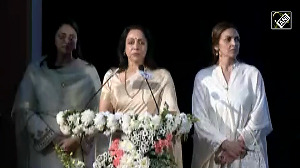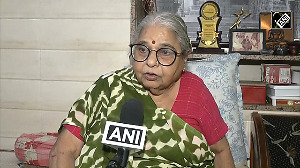Despite Chief minister Devendra Fadnavis' ambitious plan, 40 per cent of the state is reeling from drought and its water tanker economy is booming. As of February 2019, the state government declared drought in 151 of the 358 talukas.

In April 2016, Maharashtra operated the water train to supply drinking water to drought-affected Latur.
In the same year, the state embarked on its Jalyukt Shivar Abhiyan to become drought free by 2019.
Despite the ambitious plan, 40 per cent of the state is reeling from drought and its water tanker economy is booming.
Jalyukt Shivar Abhiyan aimed at making Maharashtra a drought-free state by deepening and widening streams as well as constructing cement and earthen stop dams, nullahs and digging farm ponds.
But, as of February 2019, the state government declared drought in 151 of the 358 talukas.
In these talukas, 28,524 villages have been declared drought affected.
Of this, 112 are severe drought hit.
While activists say that the Jalyukt scheme has failed after a spectacular start, government officials defend their work, claiming the last monsoon rainfall was at a historical low.
According to Central Water Commission (CWC) data, reservoir storage during the current year has been less than the storage last year for the western region, which includes the states of Gujarat and Maharashtra.
“It is also less than the average storage in the last 10 years of the corresponding period,” the commission’s report suggested.
Of the 19 reservoirs that the CWC monitors in Maharashtra, five were recorded as completely dry on May 23.
Between FY17 and FY20, the state budget allocated Rs 5,200 crore towards the Abhiyan.
Eknath Dawale, secretary, water conservation and employment guarantee scheme (EGS), said the total expenditure for the scheme from various sources stands at Rs 8,000 crore.
Despite the allocation, 40 per cent of the state is now struggling to get access to water for basic needs.
The shortage has brought to fore the conflicts yet again.
Earlier this month, the local media reported that a first information report (FIR) was filed for water theft from a residential over-head tank in Maharashtra’s Manmad district.
“The scheme started on a good note. Had they (officials) maintained the momentum, it would have worked.
"However, what started as a community work-driven scheme, got converted into a contractor-driven one, and the decline started,” said Rajendra Singh, water conservationist who is also known as waterman.
Dawale, however, refutes claims that the scheme failed.
“Nothing went wrong with the scheme. September rainfall was at a historic low of 26 per cent and storage was not replenished.
"We have created the spots. Only those works which are large are given to contractors while smaller works are community driven,” he added.
State authorities responsible for drinking water supply claim that the affected areas have been provided drinking water through tankers.
Sham Lal Goyal, additional chief secretary, water supply and sanitation department of the state, said 216 government tankers and another 5,643 private ones have been roped in to supply drinking water.
Goyal pegs the cost to government for private tankers at over Rs 4,000 per tanker per day. However, activists working on the ground point out that a tanker lobby is flourishing.
“A family of four will have to pay Rs 3,000 or more for their water needs,” said Ranjit Acharya, a Latur resident and a social activist.
That compares to the average household monthly electricity bill in a city like Mumbai.
Though private tankers are expected to supply water for free, activists add the process involves touts and other middle-men, who villagers in some parts of the state may need to pay off.
In districts like Latur, Acharya points out that water was a big issue during election campaigns.
“This has been an election issue since the last two years.
"They talk about water restoration projects and make promises of water trains.
"Last time, the water train only helped the city, not the district.
"The people feel that if something has to change, they will need to do it themselves,” he added.
Most agree that the situation will change only with community efforts.
“The Jalyukt Shivar worked well in some places like Sangli, where the community helped develop restoration projects.
"When the community builds these, they also fight for its sustainable use,” said Singh.
Parallel to the tanker economy, some of these drought-affected areas are also witnessing the boom of mineral water facilities.
“These companies set up bore wells, pump water and fill them into plastic jars and sell.
"There is no check on the water quality and these are sold at double the rate in Aurangabad,” said Subhash Lomte, social activist from the city, who was also an Aam Aadmi Party (AAP) Lok Sabha candidate in 2014.
As the state approaches the end of May, some activists feel relief for the drought-prone areas is near.
Some parts of the state start receiving early pre-monsoon showers by May-end, they added.
Goyal is also hopeful the state will not need its water train this summer.
But the recently announced delay in the onset of monsoon could mean that the worst is not yet over for farmers and others in Maharashtra.
Photograph: Jayanta Dey/Reuters











